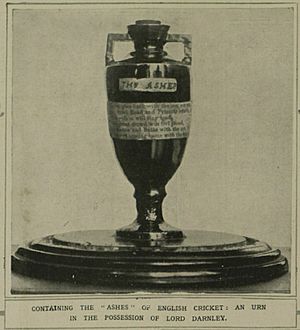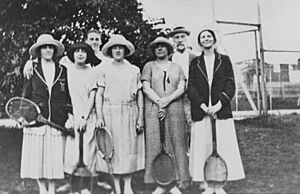History of sport in Australia facts for kids
The history of sport in Australia is a long and exciting journey. It began even before European settlers arrived. Sport has always been a big part of Australian life. It helps people connect, stay healthy, and feel proud of their country.
Contents
- The Story of Sport in Australia
- Early Days: Before the 1800s
- The 1800s: Sport Grows and Changes
- The 1900s: New Sports and National Teams
- The 1910s: Sport During Wartime
- The 1920s: Sports for Everyone?
- The 1930s: Big Sporting Moments
- The 1940s: Sport After World War II
- The 1950s: Olympic Glory and Dominance
- The 1960s: Australia's Sporting Identity
- The 1970s: Modern Sport Begins
- The 1980s: Big Wins and New Programs
- The 1990s: Media, Money, and Major Changes
- The 2000s: Sydney Olympics and Sporting Reforms
- The 2010s: Records, Expansion, and World Titles
- The 2020s: A Diverse Sporting Future
The Story of Sport in Australia
Early Days: Before the 1800s
European Settlers Bring Sports
Sport first came to Australia with the First Fleet in 1788. The early settlers brought their favorite games from Britain. These included horse racing, cricket, and boxing. Even though life was tough, many people still loved their sports.
Some important early settlers were keen on sports. Lieutenant George Johnston became a well-known horse breeder. Captain Piper also loved horse racing. These early sports helped shape Australian culture.
Aboriginal Sports and Traditions
Aboriginal people had their own rich sporting traditions. For them, sport was part of daily life and important rituals. It wasn't separate from work or leisure. Hunting and tracking, for example, were both for food and fun.
Aboriginal sports included wrestling and spear-throwing contests. They also played different types of football using balls made from possum skins. Many Aboriginal people living near the coast were skilled at swimming, fishing, and canoeing.
The 1800s: Sport Grows and Changes
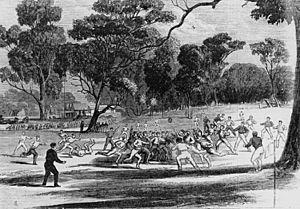
New Sports and Clubs Emerge
Organized sport truly began in Australia in 1810 with the first athletics event. Soon, clubs for cricket, horse racing, and sailing started up. Sydney was a major center for these early sports. By 1829, early forms of football were being played there.
At first, different social classes played sports in different ways. But by the late 1830s, horse racing was popular with everyone. Gambling became a part of horse racing from its early days. The Melbourne Cricket Club was founded in 1838. Sport helped bring people from different backgrounds together.
Australian Rules Football Takes Shape
By 1850, regular sports competitions were happening in New South Wales. Soon after, Queensland had rugby, and Victoria had Victorian rules football. This Victorian game, later called Australian rules football, had its rules written down in 1859.
Some Australian football clubs that still exist today were founded by 1858. The Melbourne Cricket Ground (MCG), Australia's biggest sports stadium, opened in 1853. The famous Melbourne Cup horse race began in 1861.
International Connections and Cricket
The first Australian cricket team to travel overseas was an all-Aboriginal team in 1868. They toured England, playing 47 games. This showed Australia's growing love for sport. By the 1870s, soccer was also being played in Australia.
In 1877, Australia played England in the first-ever Test Cricket match. The famous Ashes series began in 1882 after Australia beat England. The Sheffield Shield cricket competition started in 1891. Field hockey teams for both men and women were also formed by 1890.
Interstate matches in Australian rules football began in 1879. These games were very important. They showed which state had the best players. In 1897, the Victorian Football League (VFL), which later became the AFL, was founded.
The 1900s: New Sports and National Teams
Basketball started in Adelaide in 1897. The first badminton competition in Australia was held in 1900. In 1905, the first tennis Australasian Championships took place in Melbourne.
Ice Hockey and Other New Games
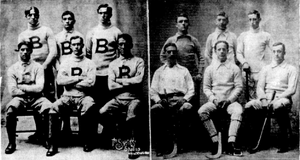
The first recorded ice hockey game in Australia was on July 17, 1906. It was played in Melbourne between a Victorian team and American sailors from a visiting warship. The game ended in a 1-1 tie.
The first recorded women's ice hockey game in Australia was in 1908. The Victorian Ice Hockey Association was formed that same year. In 1909, the first interstate ice hockey championship was held. Victoria won the Goodall Cup, which is one of the oldest ice hockey trophies outside North America.
The Rise of Rugby League

In 1907, the New South Wales Rugby League was founded. This happened after some players were unhappy with how rugby union was run. Many players decided to join the new rugby league competition in 1908. The Australia national rugby union team, known as the Wallabies, played their first international match in 1903. They won a gold medal at the 1908 London Olympics.
The 1910s: Sport During Wartime
In 1910, the Great Britain national rugby league team toured Australia and won the Ashes. Australian women first represented their country at the 1912 Summer Olympics. Surfing became popular in Australia by 1915.
The boxing career of Les Darcy began in 1915. He became a national hero. Sadly, he died at just 21 years old. His story remained important to Australians for many years.
During the First World War, many athletes joined the army. This greatly affected Australian sports. For example, the 1916 VFL season had fewer teams.
The 1920s: Sports for Everyone?
Girls and Women in Sport
In 1922, a committee looked into physical education for girls. They suggested which sports were suitable for girls. They believed some sports like football were not appropriate for girls. However, swimming, rowing, cycling, and horseback riding were seen as good choices.
National Sporting Bodies Form
Dick Eve won Australia's first Olympic diving gold medal in 1924. The first interstate women's ice hockey championship was held in 1922. The Australian Rugby League Board of Control was formed in 1924. In 1928, the Kangaroos adopted the national colors of green and gold.
In 1927, the tennis Australasian Championships became the Australian Championships. Netball Australia was also founded in 1927.
The 1930s: Big Sporting Moments
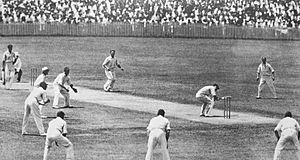
During the 1930s, playing sport on Sundays was banned in most Australian states. Rugby league grew very popular in Queensland and New South Wales. It became the main sport for spectators by 1937.
Cricket's Bodyline Series
The famous Bodyline cricket series between Australia and England happened in 1932–1933. The English team used a new, very fast bowling style to challenge Australian batters. This style, called bodyline bowling, was designed to defeat Australian batting star Donald Bradman. The series was very intense and talked about a lot.
The 1940s: Sport After World War II
After World War II, Australian women's sports were in a strong position. Their organizations had stayed active during the war. This helped them continue to grow in the years that followed.
On Boxing Day in 1945, the first Sydney to Hobart Yacht Race began. Nine yachts competed in this challenging race. In September 1949, Australian Canoeing was founded.
The 1950s: Olympic Glory and Dominance
The Australian Davis Cup team had amazing success in the 1950s. They won the cup eight times, making it their most successful decade.
In 1956, Melbourne hosted the Summer Olympics. The Melbourne Cricket Ground was the main stadium. Australia finished third in the medal count. Betty Cuthbert won three gold medals in running. Murray Rose won three gold medals in swimming.
Between 1956 and 1966, the St. George Dragons rugby league team set a world record. They won eleven straight championships!
The 1960s: Australia's Sporting Identity
Australia sent an ice hockey team to the 1960 Winter Olympics. By the 1960s, Australia was known worldwide as a country that loved sports. People within Australia also embraced this identity. In 1962, Sports Illustrated magazine called Australia the most sports-obsessed country.
Tennis Stars and Global Recognition
In 1962, Rod Laver achieved a rare feat in tennis. He won all four major tournaments, known as the Grand Slam, in one year. He did it again in 1969, becoming the only player to do so twice! He also won 200 singles titles in his career.
In 1967, Australia hosted the second Netball World Championships in Perth. That same year, South Australia became the last state to allow sports to be played on Sundays.
The 1970s: Modern Sport Begins
Sponsorship and International Challenges
From the early 1970s, sponsorship became very important for Australian sports. Money from sponsors helped both amateur and professional teams. By the mid-1980s, getting sponsors was a key skill for anyone working in sports management.
During the 1970s, Australia faced tough competition internationally. Other countries had strong government support for their sports programs. Some Australian athletes even supported political parties in advertisements.
Soccer's First World Cup
In 1974, the Australian team qualified for the 1974 FIFA World Cup. This was their first time ever reaching the World Cup! The team included Harry Williams, the first Aboriginal player for the national soccer team.
In 1977, Australian rules football interstate matches changed their rules. Players now played for their 'state of origin' (where they were born). The National Basketball League started in 1979.
The 1980s: Big Wins and New Programs
In the 1980s, rugby league was most popular in Queensland and New South Wales. Australian rules football was dominant in other states. The Australian Institute of Sport was founded in 1981. This helped train top athletes.
The annual rugby league 'state of origin' series between New South Wales and Queensland began in 1982. This became a very popular event.
America's Cup Victory
Australia had competed in the America's Cup yacht race for many years. In 1983, the Australian yacht Australia II finally won the competition! Millions of Australians watched on television as they made history.
Government Support for Sport
During the 1980s, the Australian government created several sports programs. These included Aussie Sports and Active Australia. These programs aimed to encourage more people to get involved in sport. The Australia women's national field hockey team became one of the world's top teams in 1985.
In 1989, the Victorian Football League changed its name to the Australian Football League (AFL). This showed it was becoming a national competition.
The 1990s: Media, Money, and Major Changes
In the 1990s, media rights and pay television had a big impact on sports funding. There was also less money coming from tobacco sponsorships.
Doping became a concern in the 1980s. In 1990, a law was passed to create an independent agency to control doping tests. This helped ensure fair play in sports.
Professionalism and Rugby's Big Changes
The 1990s saw big changes in rugby league. There was a major dispute over television rights, known as the Super League war. This led to two separate competitions for a while. Eventually, the two groups came together to form the National Rugby League (NRL) in 1998.
In 1995, rugby union also became professional in Australia. Australia won two Rugby World Cups in the 1990s, in 1991 and 1999. In 1998, the National Basketball League switched its season from winter to summer.
The 2000s: Sydney Olympics and Sporting Reforms

Olympic Heroes and National Pride
In 2000, Sydney hosted the Summer Olympic Games. Australia finished fourth in the medal count. It was a moment of great national pride. Cathy Freeman won the 400-meter final, becoming a hero for Aboriginal sport.
Ian Thorpe also shone at the Olympics. He won three gold medals and two silver medals in swimming. In 2000, the Australian rugby league team won the Rugby League World Cup for the sixth time in a row.
Soccer's Transformation
In 2002, the Australian government helped restructure Soccer Australia. The organization had financial problems. It changed its name to Football Federation Australia in 2005. A new national league, the A-League, started in 2004.
In 2003, Australia hosted the rugby union World Cup. The Wallabies reached the final but lost to England. The yacht Wild Oats XI set a record by winning the Sydney to Hobart Yacht Race four years in a row (2005-2008).
In 2006, Melbourne hosted the 2006 Commonwealth Games. Later that year, the Australian soccer team competed in the 2006 FIFA World Cup. This was their second appearance after 32 years! In 2008, Australia hosted the 2008 Rugby League World Cup.
The 2010s: Records, Expansion, and World Titles
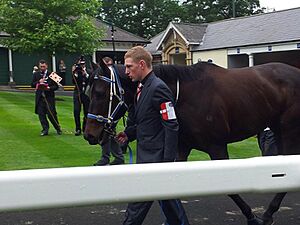
In 2009, the Melbourne Storm rugby league club faced penalties for breaking rules about player payments. The Queensland Reds won their first Super Rugby title in 2011. The AFL expanded, adding new clubs in major cities in 2011 and 2012.
In 2012, the Australian Rugby League Commission was formed. This brought an end to old conflicts in rugby league. From 2008 to 2013, the Australian racehorse Black Caviar was undefeated in 25 races. This was a record not seen in over 100 years!
In 2014, the Socceroos competed in the 2014 FIFA World Cup. In 2015, Australia hosted and won the 2015 AFC Asian Cup. Australia also won the 2015 Cricket World Cup that year. The Wallabies reached the Rugby World Cup final in 2015. In 2018, Gold Coast hosted the 2018 Commonwealth Games.
The 2020s: A Diverse Sporting Future
Today, over 20% of Australia's cricket players have South Asian heritage. Traditional Indian games like kabaddi and kho kho are also becoming more popular in Australia. This shows how diverse and connected Australian sport is becoming.


